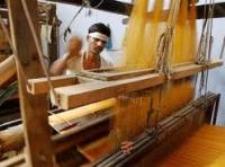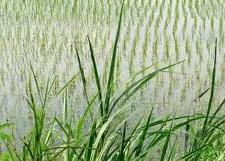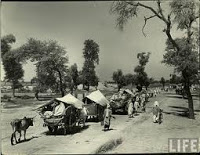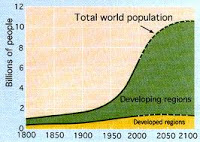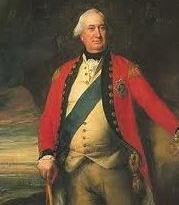India has one of the largest road networks in the world with a total length of 33.1 lakh km (2005). For the purpose of construction and maintenance, roads are classified as National Highways (NH), State Highways(SH), Major District Roads and Rural Roads. Around 70 per cent of freight traffic are carried by roads every year. Road transport is relatively suitable for shorter distance travel. Road transport in modern sense was very limited in India before World War-II. The first serious attempt was made in 1943 when ‘Nagpur Plan’ was drawn. This plan could not be implemented due to lack of coordination among the princely states and British India.
Transport and Communication in India
20 Apr 2012
By
Admin
Related Posts with thumbnails for bloggerblogger widgets
Continue reading..
Manufacturing Industries of India
19 Apr 2012
By
Admin
Industries are classified in a number of ways. On the basis of size, capital investment and labour force employed, industries are classified as large, medium, small scale, and cottage industries. On the basis of ownership, industries are categorised as : (i) public sector, (ii) private sector, and (iii) joint and cooperative sector, Public sector enterprises are government/state controlled companies or corporations funded by governments. Industries of strategic and national importance are usually in the public sector. Industries are also classified on the basis of the use of their products such as : (i) basic goods industries, (ii) capital goods industries (iii) intermediate goods industries, and (iv) consumer goods industries.
Related Posts with thumbnails for bloggerblogger widgets
Continue reading..
Mineral and Energy Resources of India
By
Admin
India is endowed with a rich variety of mineral resources due to its varied geological structure. Bulk of the valuable minerals are products of pre-palaezoic age and are mainly associated with metamorphic and igneous rocks of the peninsular India. The vast alluvial plain tract of north India is devoid of minerals of economic use. The mineral resources provide the country with the necessary base for industrial development. A mineral is a natural substance of organic or inorganic origin with definite chemical and physical properties. Minerals may be grouped under two main categories of metallics and non-metallics.
Related Posts with thumbnails for bloggerblogger widgets
Continue reading..
Water Resources | Water Management in India
13 Apr 2012
By
Admin
Water scarcity is possibly to pose the greatest challenge on account of its increased demand coupled with shrinking supplies due to over utilisation and pollution. Water is a cyclic resource with abundant supplies on the globe. Approximately, 71 per cent of the earth’s surface is covered with it but fresh water constitutes only about 3 per cent of the total water. In fact, a very small proportion of fresh water is effectively available for human use. The availability of fresh water varies over space and time. The tensions and disputes on sharing and control of this scare resource are becoming contested issues among communities, regions, and states. The assessment, efficient use and conservation of water, therefore, become necessary to ensure development.
Related Posts with thumbnails for bloggerblogger widgets
Continue reading..
Land Resources and Agriculture in India
11 Apr 2012
By
Admin
Land-use in a region is mainly influenced by the nature of economic activities carried out in that region. However, while economic activities change over time, land, like many other natural resources, is fixed in terms of its area. But composition of the economy would undergo a change over time. In other words, the secondary and the tertiary sectors usually grow much faster than the primary sector, specifically the agricultural sector. This type of change is common in developing countries like India. This process would result in a gradual shift of land from agricultural uses to non-agricultural uses. Though the contribution of the agricultural activities reduces over time, the pressure on land for agricultural activities does not decline.
Related Posts with thumbnails for bloggerblogger widgets
Continue reading..
Human Development in India | Human Development Index in India
10 Apr 2012
By
Admin
 For India, development is a mixed bag of opportunities as well as neglect and deprivations. There are a few areas like the metropolitan centres and other developed enclaves that have all the modern facilities available to a small section of its population. At the other extreme of it, there are large rural areas and the slums in the urban areas that do not have basic amenities like potable water, education and health infrastructure available to majority of this population. It is a well established fact that majority of the scheduled castes, scheduled tribes, landless agricultural labourers, poor farmers and slums dwellers, etc. are the most marginalised lot. A large segment of female population is the worst sufferers among all. It is also equally true that the relative as well as absolute conditions of the majority of these marginalised sections have worsened with the development happening over the years.Consequently, vast majority of people are compelled to live under abject poverty and subhuman conditions.
For India, development is a mixed bag of opportunities as well as neglect and deprivations. There are a few areas like the metropolitan centres and other developed enclaves that have all the modern facilities available to a small section of its population. At the other extreme of it, there are large rural areas and the slums in the urban areas that do not have basic amenities like potable water, education and health infrastructure available to majority of this population. It is a well established fact that majority of the scheduled castes, scheduled tribes, landless agricultural labourers, poor farmers and slums dwellers, etc. are the most marginalised lot. A large segment of female population is the worst sufferers among all. It is also equally true that the relative as well as absolute conditions of the majority of these marginalised sections have worsened with the development happening over the years.Consequently, vast majority of people are compelled to live under abject poverty and subhuman conditions.
Related Posts with thumbnails for bloggerblogger widgets
Continue reading..
Migration Types, Causes and Consequences | Geography
21 Mar 2012
By
Admin
Migration has been an integral part and a very important factor in redistributing population over time and space. India has witnessed the waves of migrants coming to the country from Central and West Asia and also from Southeast Asia. In fact, the history of India is a history of waves of migrants coming and settling one after another in different parts of the country. Similarly, large numbers of people from India too have been migrating to places in search of better opportunities specially to the countries of the Middle-East, Western Europe, America, Australia and East and South East Asia.
Related Posts with thumbnails for bloggerblogger widgets
Continue reading..
Population Distribution, Density, Growth and Composition | Geography
20 Mar 2012
By
Admin
The people are very important component of a country. India is the second most populous country after China in the world with its total population of 1.22 billion (2012). India’s population is larger than the total population of North America, South America and Australia put together. The first population Census in India was conducted in 1872 but its first complete Census was conducted only in 1881. Among the socio-economic and historical factors of distribution of population, important ones are evolution of settled agriculture and agricultural development; pattern of human settlement; development of transport network, industrialisation and urbanisation.
Related Posts with thumbnails for bloggerblogger widgets
Continue reading..
Develpoment on Indian Cities (1850 - 1900) | Indian History
By
Admin
In the beginning of 1600s all three cities - Madras, Calcutta and Bombay were originally fishing and weaving villages. They became important centres of trade due to the economic activities of the English East India Company. Company agents settled in Madras in 1639 and in Calcutta in 1690. Bombay was given to the Company in 1661 by the English king, who had got it as part of his wife’s dowry from the king of Portugal. The Company established trading and administrative offices in each of these settlements. By the middle of the nineteenth century these settlements had become big cities from where the new rulers controlled the country.
Related Posts with thumbnails for bloggerblogger widgets
Continue reading..
Mahatma Gandhi and the Nationalist Movement | Indian History
12 Mar 2012
By
Admin
 In January 1915, Mohandas Karamchand Gandhi returned to his homeland after two decades of stay in South Africa, where he went as a lawyer, and in time became a leader of the Indian community in that territory. It was in South Africa that Mahatma Gandhi first forged the distinctive techniques of non-violent protest known as satyagraha, first promoted harmony between religions, and first alerted upper -caste Indians to their discriminatory treatment of low castes and women. The India that Mahatma Gandhi came back to in 1915 was rather different from the one that he had left in 1893. Although still a colony of the British, it was far more active in a political sense. The Indian National Congress now had branches in most major cities and towns. Through the Swadeshi movement of 1905-07 it had greatly broadened its appeal among the middle classes. That movement had thrown up some towering leaders – among them Bal Gangadhar Tilak of Maharashtra, Bipin Chandra Pal of Bengal, and Lala Lajpat Rai of Punjab.
In January 1915, Mohandas Karamchand Gandhi returned to his homeland after two decades of stay in South Africa, where he went as a lawyer, and in time became a leader of the Indian community in that territory. It was in South Africa that Mahatma Gandhi first forged the distinctive techniques of non-violent protest known as satyagraha, first promoted harmony between religions, and first alerted upper -caste Indians to their discriminatory treatment of low castes and women. The India that Mahatma Gandhi came back to in 1915 was rather different from the one that he had left in 1893. Although still a colony of the British, it was far more active in a political sense. The Indian National Congress now had branches in most major cities and towns. Through the Swadeshi movement of 1905-07 it had greatly broadened its appeal among the middle classes. That movement had thrown up some towering leaders – among them Bal Gangadhar Tilak of Maharashtra, Bipin Chandra Pal of Bengal, and Lala Lajpat Rai of Punjab.The three were known as “Lal, Bal and Pal”, the alliteration conveying the all-India character of their struggle, since their native provinces were very distant from one another. Where these leaders advocated militant opposition to colonial rule, there was a group of “Moderates” who preferred a more gradual and persuasive approach. Among these Moderates was Gandhiji’s acknowledged political mentor, Gopal Krishna Gokhale, as well as Mohammad Ali Jinnah. On Gokhale’s advice, Gandhiji spent a year travelling around British India, getting to know the land and its peoples.
Related Posts with thumbnails for bloggerblogger widgets
Continue reading..
Partition of India | History of India
7 Mar 2012
By
Admin
 The Partition of British India into the sovereign states of India and Pakistan led to many sudden developments. Thousands of lives were snuffed out, many others changed dramatically, cities changed, India changed, a new country was born, and there was unprecedented genocidal violence and migration. Partition was a culmination of a communal politics that started developing in the opening decades of the twentieth century. They suggest that separate electorates for Muslims, created by the colonial government in 1909 and expanded in 1919, crucially shaped the nature of communal politics. Over 10 million people were uprooted from their homelands and forced to migrate.
The Partition of British India into the sovereign states of India and Pakistan led to many sudden developments. Thousands of lives were snuffed out, many others changed dramatically, cities changed, India changed, a new country was born, and there was unprecedented genocidal violence and migration. Partition was a culmination of a communal politics that started developing in the opening decades of the twentieth century. They suggest that separate electorates for Muslims, created by the colonial government in 1909 and expanded in 1919, crucially shaped the nature of communal politics. Over 10 million people were uprooted from their homelands and forced to migrate.
Related Posts with thumbnails for bloggerblogger widgets
Continue reading..
Framing of Indian Constitution | Indian History
6 Mar 2012
By
Admin
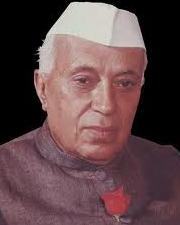 The Indian Constitution, which came into effect on 26 January 1950,has the dubious distinction of being the longest in the world. But its length and complexity are perhaps understandable when one considers the country’s size and diversity. At Independence, India was not merely large and diverse, but also deeply divided. A Constitution designed to keep the country together, and to take it forward, had necessarily to be an elaborate, carefully-worked-out, and painstakingly drafted document. For one thing, it sought to heal wounds of the past and the present, to make Indians of different classes, castes and communities come together in a shared political experiment. On 15 August 1947, India had been made free, but it had also been divided. Through the late 1940s the two leading Indian political parties, the Congress and the Muslim League, had repeatedly failed to arrive at a settlement that would bring about religious reconciliation and social harmony. The Great Calcutta Killings of August 1946 began a year of almost continuous rioting across northern and eastern India The violence culminated in the massacres that accompanied the transfer of populations when the Partition of India was announced.
The Indian Constitution, which came into effect on 26 January 1950,has the dubious distinction of being the longest in the world. But its length and complexity are perhaps understandable when one considers the country’s size and diversity. At Independence, India was not merely large and diverse, but also deeply divided. A Constitution designed to keep the country together, and to take it forward, had necessarily to be an elaborate, carefully-worked-out, and painstakingly drafted document. For one thing, it sought to heal wounds of the past and the present, to make Indians of different classes, castes and communities come together in a shared political experiment. On 15 August 1947, India had been made free, but it had also been divided. Through the late 1940s the two leading Indian political parties, the Congress and the Muslim League, had repeatedly failed to arrive at a settlement that would bring about religious reconciliation and social harmony. The Great Calcutta Killings of August 1946 began a year of almost continuous rioting across northern and eastern India The violence culminated in the massacres that accompanied the transfer of populations when the Partition of India was announced.
Related Posts with thumbnails for bloggerblogger widgets
Continue reading..
Deccan Riots of 1875 | Deccan Riots Commission
20 Nov 2011
By
Admin
As British rule expanded from Bengal to other parts of India, new systems of revenue were imposed. The Permanent Settlement was rarely extended to any region beyond Bengal. Since the revenue demand was fixed under the Permanent Settlement, the colonial state could not claim any share of this enhanced income. Keen on expanding its financial resources, the colonial government had to think of ways to maximise its land revenue. So in territories annexed in the nineteenth century, temporary revenue settlements were made. The revenue system that was introduced in the Bombay Deccan came to be known as the
ryotwari settlement
. Unlike the Bengal system, the revenue was directly settled with the ryot. The average income from different types of soil was estimated, the revenue-paying capacity of the ryot was assessed and a proportion of it fixed as the share of the state.
Related Posts with thumbnails for bloggerblogger widgets
Continue reading..
Permanent Settlement by Charles Cornwallis
By
Admin
The Permanent Settlement had come into operation in 1793. The East India Company had fixed the revenue that each zamindar had to pay. The estates of those who failed to pay were to be auctioned to recover the revenue. In those days Raja was a term that was often used to designate powerful zamindars. In 1797 there was an auction in Burdwan (present day Bardhaman). It was a big public event. A number of mahals (estates) held by the Raja of Burdwan were being sold. Since the raja had accumulated huge arrears, his estates had been put up for auction. Likewise over 75 per cent of the zamindaris changed hands after the Permanent Settlement.
Related Posts with thumbnails for bloggerblogger widgets
Continue reading..


